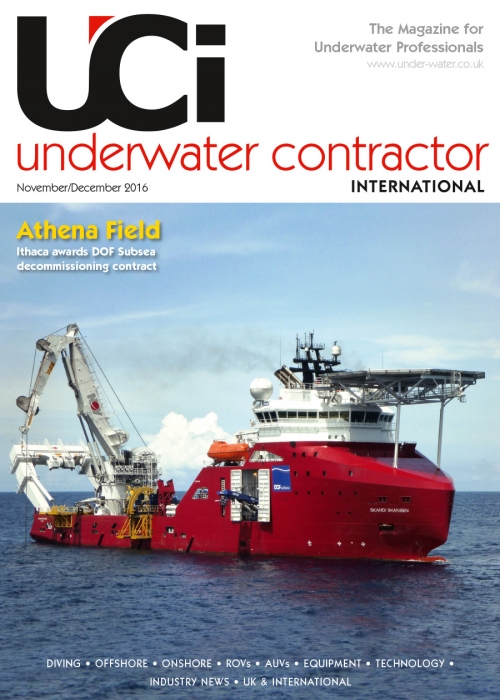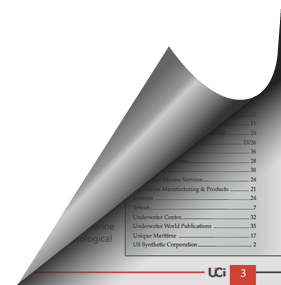
The Magazine for Underwater Professionals
![]() Jul/Aug 2015
Jul/Aug 2015
INDUSTRY NEWS - OPERATIONS
Pipelay record
EMAS AMC, the subsea division of Singapore-headquartered EMAS, the global offshore contractor and provider of integrated offshore solutions to the oil and gas industry, reports its flagship subsea construction vessel, Lewek Constellation, has established an industry record for pipelay in the US Gulf of Mexico. The ice-class, DP3 vessel laid pipe in 7368 feet (2246 metres) of water during her sea trials.
She was performing her final pipelay trial in the Gulf of Mexico in preparation for the execution of three subsea tie-back projects for Noble Energy, USA. During the deployment of the 3.2-kilometre, 16-inch (40.6-centimetre) diameter, 28-millimetre wall thickness pipeline, complete with the second end pipeline end termination (PLET), the tension recorded was 632 tonnes, rendering this the highest tension ever experienced in the history of rigid reeled-lay operations, according to EMAS.
“Successfully laying the test pipe at this record-breaking top tension during pipelay trials is a significant achievement for EMAS and an industry first,” said Lionel Lee, chairman, EMAS AMC. “It’s a testament to the experience and expertise of our people combined with the quality of our new vessel built by EMAS Group’s subsidiary TRIYARDS in Vietnam. I want to acknowledge the hard work and dedication of our integrated project teams in preparation for this important milestone.”
“What this record means for clients going forward is that we can offer a more efficient pipelay solution in ultra-deepwater for pipelines up to 16 inches in diameter when compared to traditional S-lay or J-lay methods, even with thick insulation coatings, thereby giving our clients more options to consider,” said John Meenaghan, vice president of global operations.
US-headquartered subsea ROV operator Canyon Offshore has mobilised two new Schilling Robotics, USA, UHD-III ROVs to its latest vessel, Grand Canyon II. The company said the vehicles will enhance its reputation for having the most robust and flexible systems for subsea field work.
The Grand Canyon II is designed to perform a broad range of subsea operations, with DP3-class station keeping for work in severe weather conditions. It features a 250-tonne heave compensated crane and facilities to launch port and starboard side ROVs simultaneously.
The vessel’s first project was for survey and trenching work in the UK. The UHD-IIIs were utilised continuously for a four-week period, with only one hour of maintenance time.
“We are delighted to have installed two new UHD-III ROVs, complete with heave compensated launch and recovery systems, on board the Grand Canyon II, the second in the series of our flag ships. The UHD-III ROVs are already proving to be great assets,” said Ian Edmonstone, president for Canyon Offshore.
UK-based Teledyne Bowtech reports it supplied LED-V-20K lamps, a Surveyor-HD-Pro camera and a 3D-HD system to Curtin University, Australia, and the Western Australian Museum to survey the shipwrecks of Australian warship HMAS Sydney II and the German raider HSK Kormoran in the Indian Ocean 200 kilometres west of Shark Bay, Western Australia.
An array of ten LED-V-20K lamps, emitting up to 20,000 lumens each, were used on each of two ROVs to illuminate the wreckage which was filmed using a Surveyor-HD-Pro camera and a 3D-HD camera system.
The Surveyor-HD-Pro is a state-of-the-art high-definition camera with full 1080p 50/60. It has a water corrected fused quartz hemisphere window and titanium housing rated to 6000 metres.
The 3D-HD is a high-definition stereoscopic camera, also rated to 6000 metres operating depth. “Three-dimensional imaging is invaluable for ROV manipulation tasks; the perception of depth enables the operator to carry out difficult and time-consuming operations faster and more safely. In all operations subsea, and especially important to marine archaeology, 3D provides a tremendous spatial awareness that is not achieved through normal 2D vision,” said Bowtech.
Dr Andrew Woods, research engineer at the Centre for Marine Science & Technology at Curtin University, said: “The lights performed really well providing some rich colours and wonderful lighting effects. The Surveyor-HD-Pro camera operated flawlessly. We’ve captured some amazing footage”.
He hailed the expedition “a raging success” due in part to good weather, reliable equipment and very careful planning. “All of our goals were met, including many of our stretch goals. There have been comments that we’ve set a new benchmark in maritime archaeology, which is what we set out to do,” he said.
The research team now has the task of reviewing the 50 terabytes of data, around 700,000 still images and some 300 hours of high-definition video, collected during the week-long survey.
The HMAS Sydney II and the HSK Kormoran were destroyed in battle on 19 November 1941 off Western Australia. For many years the fate of the Sydney and her 645 crew was a mystery until both wrecks were found in 2008. Photographs taken at that time did not explain how Sydney could have been so comprehensively disabled. However, new images taken by Dr Woods and his team clearly show damage which supports the theory that the bridge was destroyed and the ship’s command structure lost early in the battle, as reported by a survivor from the Kormoran.
The intention is that the images of both shipwrecks will be used to create multi-platform museum exhibitions to capture the unique heritage value of these ships for future generations and to honour the lives lost in what is still Australia’s greatest naval tragedy.
UTEC Geomarine, the geotechnical service line of UTEC Survey, UK, has successfully completed the first phase of a geotechnical site investigation in the Caspian Sea for a major oil and gas operator.
The project was completed using a cost-effective, time-efficient suite of ROV conveyed technology, comprising of UTEC’s patented geoROV seabed cone penetration test (CPT) and sampling system, geoREACT suction skid, and a specially developed rotary core drill, according to a spokesman.
“UTEC Geomarine’s geoROV technology is an ROV-compatible, CPT, T-bar and push sampling tool,” the spokesman said. “Key benefits include portability, cost-effectiveness and productivity.”
He added: “The geoROV returns high quality soils data at any water depth. The geoROV drive unit mounts to all work-class ROVs and after initial mobilisation takes less than one hour to fit or remove. It can be deployed alongside or in between other subsea ROV works, and provides real-time data transmission. Additionally, geoREACT, an ROV tool skid designed to provide additional stability and reaction force for seabed investigation, enabled testing and sampling to take place over the full range of seabed types on this project.”


